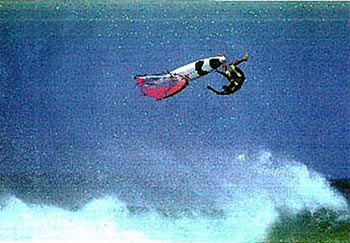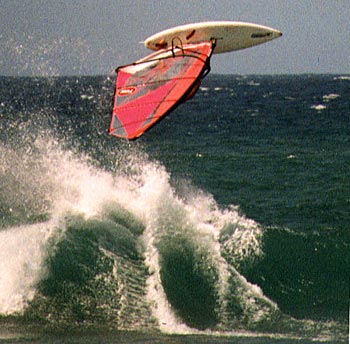Kettlebells for Surfing Strength and Muscle Endurance
Matt Schwartz, RKC
January 12, 2005 07:41 AM


Matt the Wave Rat.This article will not directly address agility, balance, or explosiveness, although the dynamic nature of the exercises below will definitely enhance those attributes as well.
We will cover training these 3 different athletic attributes for surfing performance:
- Upper body muscle endurance for paddling out while being repeatedly pounded by waves.
- Lower body power for taking late drops and hard turns.
- Overall body toughness for handling wipeouts and awkward positions.
Kettlebells, along with some complementary bodyweight calisthenics are just the ticket for thoroughly addressing these attributes!
Surfing is a sport that should really be called paddling since that is what surfers spend most of their time doing. A lot of that paddling involves max sprint efforts trying to claw out through the surf. Surfers need to sprint to gain ground between waves and then hold their breath as the next oncoming wave tries to rip them off their boards every 15 seconds or so. Depending on what the conditions deliver, a surfer may have to duck dive between 0 and 100+ waves in one paddle out. So, he will need some serious muscle endurance and will need to be ready work at a high heart rate. Kettlebells allow one to do just that (insert an evil laugh here)!
High repetition swings and other ballistics are the ticket. Sets of 10-50+ reps with 30-60 seconds of rest between sets are a good prescription. Applicable exercises include swings, snatches, cleans, jerks, and variations. Additionally, Hindu pushups are very useful for full body muscle endurance and enhancing the spinal flexibility critical to the movements of paddling and making smooth drops. A modified Hindu pushup that I call the Hindu squat thrust is a great strength endurance builder that also mimics the motions of making the drop on a surfboard. It's essentially a squat thrust that includes a hindu pushup in the bottom position before popping up onto your feet. I recommend a circuit style workout that rotates through the different exercises and keeps your heart rate up. For example, a set of swings, a set of Hindu squat thrusts, a set of snatches, a set of under-the-leg passes, and a set of cleans and jerks could be one circuit.
Surfers generally have decent upper body strength but their leg strength is usually lacking in comparison. For leg and hip power, the ballistic exercises listed above are a great start and are good at developing some leg drive, but specialized lower body exercises are more specifically beneficial. These include lunges, front squats, duck walks, and overhead squats, all possible with or without holding kettlebells. Movements like the dragon walk are also very useful for learning to generate and control the twisting power that is so important when hitting a cutback or landing an air drop. Low reps with high intensity is the key concept here to make your legs strong and injury-proof in the surf. A more explosive rep style similar to the surfing movement is also useful, but I recommend cycling that with a grinding rep style for variety. And, for those who are up to it, the pistol is the king of strength and balance builders for the stand-up power needed in surfing. As always, follow the party line here; these high-tension strength exercises should be performed early in the workout before the high-rep ballistics.
Next, we'll talk about learning to deal with the beatings that waves deliver. Surfing is by nature a sport that takes place in a changing and unpredictable environment. The surfer needs to develop athletic attributes that allow him to work in an unstable environment. The dynamic instability of kettlebell training accomplishes just that. Kettlebell training teaches the surfer dynamic balance needed to adapt to the changing variables and awkward positions we encounter on a wave, such as a bumpy wave face or warbly tube. More significantly, the ballistic nature of kettlebell training toughens the body's connective tissues better than any exercise I have ever performed. This is key when dealing with the beatings that waves so regularly dish out. When being worked over by a wave, a surfer needs to be able to do several things to remain intact:
- Be able to hold on to, or at least safely get away from his board under the wave if necessary.
- Keep his joints in a safe position while all that water force is ripping him in several different directions simultaneously.
- Protect his body from impact with the bottom, his board, or the water itself.
Kettlebells address item 1 by building strong grip strength, as well as core stability that will allow you to stay centered and hang onto the board under water. Kettlebells address item 2 in two ways. First, the ballistic nature of the training builds strong connective tissues in joints including the low back, shoulders, and knees, areas which are more exposed in the surfer when being worked over. Second, the proprioception and joint control that proper kettlebell lifting teaches will carry over to the surfer. He will have learned to keep his shoulders in their sockets, his core engaged, and his hamstrings in command of his knees when the water is trying to separate his limbs from his body. Finally, as per item3, the impact of the water itself can feel like someone is punching you, or worse, so the body toughening effects of kettlebells and proper breath control will help protect the surfer.
If you surf more than 4 days per week, you may want to concentrate more on the leg workouts since you are probably already getting a lot of upper body work just from paddling. And surfing is not much of a leg workout by comparison. If you are a weekend warrior and really strapped for time, I recommend focusing more on the full?body ballistic exercises. In either case, all the exercises will be helpful if you have the time and energy, so try to do each of them at some point.
If you want to surf well you need to paddle well, have good dynamic lower body strength, and be able to take the knocks that are dished out every session. If you can do those things well you will be able to rip in the small waves and charge in the big stuff. Kettlebells mixed with bodyweight exercises are my primary dryland tool for achieving those goals.
A Sample WorkoutStart with a joint mobility warm-up, each movement about 5x in each direction:
- Neck forward and back bends
- Neck side to side bends
- Neck side to side rotations
- Egyptian shoulder rotations
- Chest opening arm swings horizontal plane
- Chest opening arm swings vertical plane
- Hip rotations
- Knee and ankle rotations
- Knee lifts to chest
- A few deep squats
The workout:
- Choose 2 of the following strength exercises and perform 2-3 sets of 3-5 reps each in high-tension style:
- Front squats
- Weighted lunges
- Weighted or unweighted duck walk (walking while in a deep squat position ?a great surfer exercise, but only for healthy knees).
- Dragon walk
- Overhead squats or overhead lunges
- Hack squats
- Pistols
- 1-3 circuits of:
- 10 swings two-handed or left/right
- 10 under-the-leg passes
- 10 snatches left/right
- 10 Hindu squat thrusts or Hindu pushups
- 10 clean-and-jerks left/right
- Janda situps or another ab exercise. 2 sets x 5 reps.
Make sure to at least do a quick stretch of the following areas when done: the hip flexors, hams, glutes, pecs, lats.

Back